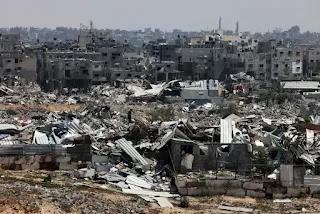Israeli military says it has withdrawn its forces from Khan Younis after months of fighting
 |
It’s unclear what the withdrawal means for Israel’s plans to invade Rafah, the southernmost part of Gaza that has become a shelter for hundreds of thousands of Palestinians. Israel has said an incursion into Rafah is essential to achieve its goal of eliminating Hamas from Gaza.
Israeli Defense Minister Yoav Gallant said Sunday that the troops were leaving Gaza to prepare for follow-up missions, including in the Rafah region.
“The troops exit and prepare ahead of their follow-up missions. We saw examples of such missions in action in Shifa. And also for their follow-up mission in the Rafah region,” Gallant said in remarks during his visit to the military’s Southern Command.
“We are reaching a situation where Hamas does not control the Gaza Strip and that it does not function as a military framework that poses a risk to the citizens of the State of Israel,” Gallant said, noting that he has completed a situational assessment of the IDF Southern Command as its forces are pulling out of Khan Younis.
The defense minister added that Israeli forces in Khan Younis were successful in destroying “enemy targets, warehouses, weapons, underground [infrastructure], headquarters [and] communication rooms.”
Israeli public broadcaster and CNN affiliate Channel 11 on Sunday reported that the remaining forces would be located along the so-called Netzarim Corridor, a route that splits the Gaza Strip in two. Named after the former Israeli settlement of Netzarim in Gaza, the corridor intersects one of Gaza’s two main north-south roads, Salaheddin Street, to create a strategic, central junction.
Before pulling out, the IDF on Sunday said that commando units had raided and searched more than a hundred locations in the Al-Amal neighborhood of Khan Younis, where it found a long tunnel and “eliminated terrorists.” CNN cannot independently verify those claims.
Speaking to ABC’s “The Week,” White House National Security Communications Adviser John Kirby said it was unlikely the move was sign of some incoming new operation but rather a “rest and refit.”
“They’ve been on the ground for four months. The word we’re getting is they’re tired, they need to be refit.”
The US is Israel’s major ally but has been pressuring the country to do more to protect civilians and allow in aid.
In a call this week between US President Joe Biden and Israeli Prime Minister Benjamin Netanyahu, Biden told Netanyahu to take steps to address the crisis or face consequences.
 |
| nternational pressure has been mounting on Israel, with close ally the US calling for more to be done to protect civilians. Mohammed Abed/AFP/Getty Images |
The IDF began its campaign against Hamas in Gaza’s north soon after the October 7 attacks that killed about 1,200 people. Early in the war, the Israeli military designated Khan Younis as a safer zone and told residents from northern Gaza to seek shelter there.
But as the IDF increasingly switched its focus to the south, the city became a battleground.
On December 1, the Israeli military launched a massive air raid operation on Khan Younis, dropping leaflets into the city telling residents to immediately evacuate.
Since then, it has been a site of intense fighting, leaving the area devastated. Visiting the scene earlier in the year, CNN found buildings completely destroyed or others beyond repair.
The IDF says the city is a Hamas stronghold, adding that the tunnel network underneath civilian buildings in the city was likely where Hamas planned the October 7 attacks from. The city is the hometown of Hamas’ leader in Gaza, Yahya Sinwar.
Hamas has denied hiding in hospitals and other civilian structures and CNN cannot independently verify either claim.
This story has been updated with additional developments.

No comments:
Post a Comment